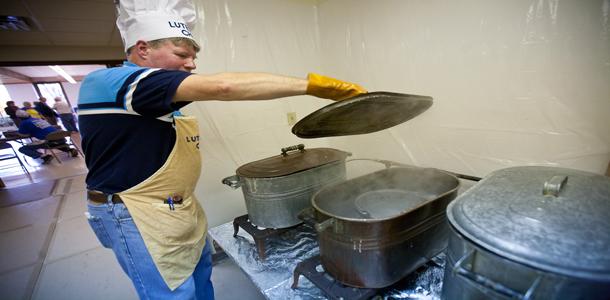Approximately 10 months ago, a codfish was caught in Scandinavian waters. It was cleaned, had its head and fins removed, and left to hang on top of the Norwegian fjords for three months until the cool air dried it out so much, that it had the consistency of a piece of wood.
After that it was stacked on a pallet, and sent to a facility in Minnesota where the fillet was soaked in a lye solution for 30 days, and then a salt brine solution for 30 days.
The fillet was then shipped to the Lakeview Lutheran Church on Madison’s North side where it, and about 1,000 more pounds of fish was served to almost 1,200 people on Nov. 4.
“Lutefisk is an old preservation method, the season for cod is December through January, they would dry the fish out on the fjords in these big hangers that looked like bleachers,” said Nelson Walstead.
Walstead has been running the dinner for about 25 years so he knows a thing or two about the history of the interesting dish.
“About 60 years ago, the dinner started out as a fundraiser for the church, the North side of Madison was expanding rapidly and the church had nearly 2,000 members. After about five years they were able to use the money from the dinner to build a whole new section on the church and the dinner has been an annual tradition ever since,” said Walstead.
Lutefisk has a reputation for not being the most appetizing of dishes, in fact, Wisconsin Statute 101.58 gives lutefisk a specific exemption from being a toxic material. Don’t believe the hype, lutefisk isn’t stinky, briney or mushy, and it is pretty tasty when dished up properly.
Cheryl Krull, who has been coming to the dinner since the late 70’s said that it is best when seasoned with salt and pepper, melted butter, and a little dab of mashed potatoes and then wrapped in lefse, a thin tortilla like bread native to Scandinavia. You can then spread some butter and brown sugar on another piece of lefse and have that for dessert.
The fish along with mashed potatoes, green beans, coleslaw, rutabagas, Swedish meatballs and cranberry sauce are served family style during the lunch and dinner.
The event is a community tradition and people come from all over to eat. Roxana Weiner and Paula Klubertanz from Waterloo and Portage came to try it for the first time. Both of them were pleasantly surprised.
“You hear that it’s so bad, but it’s not fishy or overpowering at all,” Weiner said.
Although lutefisk might seem weird, it is a very important method of survival in Scandinavia. Just like smoking or salting, it allowed people to live in otherwise inhabitable places.
Most of the nation’s lutefisk is consumed in the Midwest which makes sense given the large percentage of northern European immigrants that settled here. Many of the people at the meal had parents who were first generation immigrants, who grew up on food like lutefisk.
The dinner is a once a year thing, however, if you can’t wait until next year to try this historic fish dish, you can pick some up at Woodman’s or ask your local meat market owner.
























